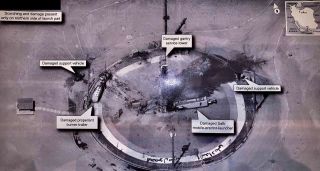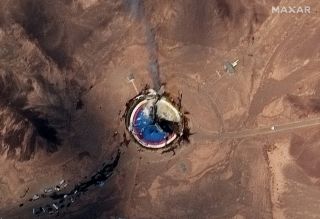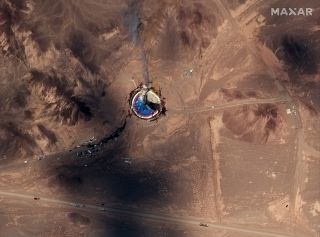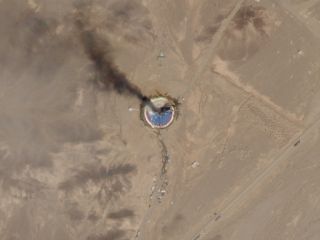Kaboom! The Biggest Space Bloopers of 2019 – Space.com
Spaceflight is hard, and sometimes things don’t go to plan. But by looking at past missions and learning from their mistakes, we can make future missions all the better. The year 2019 had a few major “lessons learned” for entities all around the world.
From difficulties landing on the moon, to a few rocket explosions, engineers definitely had some new things to think about for the next time.
Related: The Greatest Spaceflight Moments of 2019
Iran rocket failures




Iran experienced its fair share of rocket failures in 2019. In January, the third stage of a rocket called Simorgh did not reach its “necessary speed” to successfully heft the Payam satellite into its planned orbit, Telecommunications Minister Mohammad Javad Azari Jahromi told AP News.
In February, satellite images from company DigitalGlobe showed an Iranian satellite called Doosti (“Friendship” in Persian) likely launched, but multiple sources suggested it did not make it safely to orbit. Then in August, more satellite imagery from Planet showed a rocket that had apparently exploded on the pad, in footage that was first shared exclusively with NPR.
China rocket & satellite failure
This nation had an extraordinarily productive late 2019, when (among many other milestones) it successfully launched two rockets in three hours from different launch sites – and two rockets in six hours from the same launch area. But there were some mistakes along the way.
Chinese private company OneSpace had a launch failure in March 2019 that was later attributed to a gyroscope issue. In May, a Long March 4C rocket from the Chinese government failed during launch, due to an issue with the rocket’s third stage. An August launch of a Long March 3B rocket appeared to go well at first, but then its main payload — the Chinasat 18 satellite — failed to communicate with Earth.
Israel’s moon crash
In April of this year, Israel aimed for the moon with a novel lander called Beresheet built by the private group SpaceIL. The probe, which launched Feb. 21 on a SpaceX Falcon 9 rocket, was poised to become the first privately built moon lander to softly set down on the lunar surface. But when it arrived at the moon on April 11, something went wrong.
Instead of landing safely on the moon’s Sea of Serenity, Beresheet missed its landing burn and crashed into the lunar surface instead. Despite the failure, SpaceIL has vowed to build a new Beresheet and return to the moon in the mid-2020s.
SpaceX Crew Dragon abort explosion
An engine test of SpaceX’s Crew Dragon, which will eventually bring astronauts to the International Space Station, did not go to plan on April 20. Local media reports and images showed a huge plume of smoke emanating from the test site.
“Earlier today, SpaceX conducted a series of engine tests on a Crew Dragon test vehicle on our test stand at Landing Zone 1 in Cape Canaveral, Florida,” a company spokesperson told Space.com in a statement. “The initial tests completed successfully, but the final test resulted in an anomaly on the test stand.” A leaky valve and faulty component were later found to be the causes of the fire.
SpaceX has since fixed the problem and performed a series of successful ground tests of Crew Dragon’s abort system. The company will launch an uncrewed In-Flight Abort test flight no earlier than Jan. 11, and aims to begin flying people to the space station in 2020.
Arianespace Vega failure
French company Arianespace experienced a major anomaly in July when its Vega rocket, carrying the United Arab Emirates’ FalconEye1 satellite, failed to get the rocket or the satellite safely into space. In September, the European Space Agency said that the Z23 motor – which powers the second stage of the rocket – was the cause.
“The commission identified the anomaly’s most likely cause as a thermo-structural failure in the forward dome area of the Z23 motor,” ESA wrote In a statement. Vega will most likely return to flight in 2020 once corrective action is taken to stop the failure from happening again, the agency added.
India’s moon crash
On Sept. 6, the India Chandrayaan-2 moon lander Vikram made a descent to the moon — then stopped communicating with Earth.
The Indian Space Research Organisation spent more than two months trying to find the little lander, before determining that it had indeed crashed on the surface. The suspected cause is an issue with the braking thrusters, which were supposed to slow down Vikram during its last few feet before soft-landing. Vikram instead “hard landed” within view of its landing site.
A stuck “mole” on Mars
The InSight Mars lander experienced a number of issues trying to get its drill deep enough into the Martian surface to look at heat flow on the Red Planet.
During several attempts, the “mole” got stuck because the regolith (soil) was harder than expected. At one point, the mole even popped out of the hole. Engineers eventually hit upon the idea of using a robotic arm to pin the drill against the soil during penetration.
As of late December, the mole is moving under the surface again.
Exos Aerospace rocket crash
An Exos Aerospace suborbital sounding rocket (which flies into the upper atmosphere) failed during a launch attempt on Oct. 26. The Suborbital Autonomous Rocket with GuidancE (SARGE) rocket’s mission ended after the launch attempt at Spaceport America in New Mexico.
The problem was later traced to the failure of a part underneath the nose cone; the nose cone fell back into the rocket and the rocket’s trajectory veered beyond recovery.
SpaceX’s Starship prototype pops
Starship Mk1 had an anomaly in November, blowing its top during a cryogenic pressure test at SpaceX’s facilities near the South Texas village of Boca Chica.
SpaceX plans to move to more advanced prototypes of Starship rather than repairing and retesting this particular one, CEO Elon Musk said in a tweet. These prototypes are forming part of the testing program for Starship, which is expected to bring astronauts into deep space (including Mars) in the coming years.
SpaceX was already building a second Starship prototype, the Mk2, in Florida. After the Mk1 anomaly, the company decided to put its resources behind the construction of a third new prototype, the Mk3, at its Boca Chica test site.
Boeing Starliner in wrong orbit
Like SpaceX, Boeing has a NASA contract to fly eventually fly astronauts on trips to the International Space Station. To do that, Boeing has built a new space capsule, called the CST-100 Starliner, which is designed to launch into orbit on an Atlas V rocket, dock itself at the station and return to Earth to make a land-based landing with parachutes and airbags.
On Dec. 20, Boeing launched the first Starliner test flight to the International Space Station, but the uncrewed mission never made it to its destination. A mission clock error caused the Starliner to think it was in a later part of its mission, leading the spacecraft to use propellant it vitally needed for the trip to the station. In the end, Starliner’s clock error and a communications issue forced Boeing to abandon hopes of reaching the space station. The planned eight-day mission was cut to just three, with Starliner returning to Earth and landing successfully.
While Starliner successfully launched and landed, its failure to reach the space station has NASA and Boeing discussing whether another uncrewed test flight will be required before astronauts can start flying on the spacecraft in 2020.
Follow Elizabeth Howell on Twitter @howellspace. Follow us on Twitter @Spacedotcom and on Facebook.







